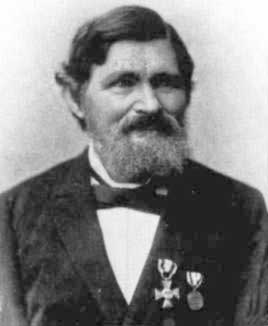


 تاريخ الرياضيات
تاريخ الرياضيات
 الرياضيات في الحضارات المختلفة
الرياضيات في الحضارات المختلفة 
 الرياضيات المتقطعة
الرياضيات المتقطعة
 الجبر
الجبر
 الهندسة
الهندسة 
 المعادلات التفاضلية و التكاملية
المعادلات التفاضلية و التكاملية 
 التحليل
التحليل
 علماء الرياضيات
علماء الرياضيات |
Read More
Date: 13-11-2016
Date: 13-11-2016
Date: 12-11-2016
|
Died: 11 March 1895 in Kiel, Herzogtum Holstein, Prussia

Ernst Meissel was born in Neustadt-Eberswalde, a town about 75 km northeast of Berlin in northern Brandenburg. He attended the Friedrich-Wilhelm Gymnasium in Berlin, completing his secondary education in 1847. He then spent three years studying mathematics at the University of Berlin working under Jacobi. He also had contacts with Dirichlet who was teaching at the University of Berlin at the time Meissel was studying there. His doctorate was obtained from Halle in 1850 for the dissertation De serie quaedam Jacobiana.
After obtaining his doctorate, Meissel remained in Berlin studying for the necessary qualifications to become a secondary school teacher of mathematics. He completed his training around April 1852 and became a mathematics teacher at the Bergakademie in Berlin. This Academy had been founded in 1770 by the Prussian King Friedrich II to train students in mineralogy. He also taught at the Bauakademie, the Academy of Architecture, which had opened in 1836. The Academy was housed in a beautiful building designed by the famous architect Karl Friedrich Schinkel and built during the years 1832-36 on the west bank of the Spree river in Berlin.
Meissel left Berlin, and his positions there, in 1852 when he was appointed as director of the Royal Provinzialgewerbeschule in Iserlohn, which is situated about 25 km south of Dortmund. He held this post until 1871 when he moved to Kiel as director of the Knabenbürgerschule. Two years after taking up the post his school became a Realschule, then in 1882 an Oberrealschule. Today the school is called Humboldt-Schule and is situated in Knooper Weg in central Kiel. He remained at this school in Kiel until the end of his life.
Little is known of Meissel's private life. We do know that he was married and had at least two sons. One son, W Meissel, worked for Norddeutscher Lloyd, Bremerhaven. Certainly it is known that in 1901 he was based in Hong Kong and he refloated the steamship München which had run aground on Yap, Caroline Islands. The only information about the other son is tragic since it is reported that he died at a young age after being hit by a snowball.
Meissel's mathematical work covers a number of areas. Peetre writes in [2]:-
Meissel's mathematical interests covered the following fields: number theory (in particular, properties of prime numbers), theta functions, elliptic functions, spherical trigonometry, hydrodynamics, ordinary differential equations, asymptotic expansions, and Bessel functions. In particular, Meissel was a master calculator, as witnessed by the many tables he worked out and the extensive numerical calculations he performed. These evoked admiration among his contemporaries ...
He worked on prime numbers and found, in the 1870s, a method for computing individual values of π(x), the counting function for the number of primes less than or equal to x. His method was based on recurrences for partial sieving functions, and he used it to compute π(107), π(108), and π(109). He found that there are 664,599 primes less than 107, there are 5,761,455 primes less than 108 and 50,847,478 primes less than 109. However Derrick Lehmer simplified and extended Meissel's method 70 years later, and showed Meissel's value of π(109) was too small by 56. Recently Deléglise and Rivat, using a technique based on that of Meissel and Derrick Lehmer, showed that π(1018) = 24,739,954,287,740,860. Another piece of work by Meissel on number theory is discussed in [1].
In addition to his work on primes, Meissel did other number theory work, namely on Möbius inversion and the theory of partitions. He also wrote on Bessel functions, asymptotic analysis, refraction of light in the earth's atmosphere, and the three body problem. His work on the three body problem is discussed in detail in [3].
His main skill was in numerical calculations and manipulation of complicated expressions. His work was based on the mathematics he learnt as a student and he appears not to have kept up with new developments. Peetre gives this conclusion in [2]:-
Meissel must be judged as a classical mathematician, continuing a tradition from an earlier epoch associated with names like Euler, Laplace, Legendre, Gauss, Jacobi, and Dirichlet. His work is based entirely on things that he learnt during his student days (before 1850), whereas he seems to have been ignorant of newer developments in analysis such as the theory of functions of one complex variable. In other respects he was ... a forerunner (in the theory of Bessel functions, in connection with Emden's equation etc.). Moreover he was extremely skilled in numerical calculations and in manipulating complicated analytic expressions.
Articles:



|
|
|
|
التوتر والسرطان.. علماء يحذرون من "صلة خطيرة"
|
|
|
|
|
|
|
مرآة السيارة: مدى دقة عكسها للصورة الصحيحة
|
|
|
|
|
|
|
نحو شراكة وطنية متكاملة.. الأمين العام للعتبة الحسينية يبحث مع وكيل وزارة الخارجية آفاق التعاون المؤسسي
|
|
|